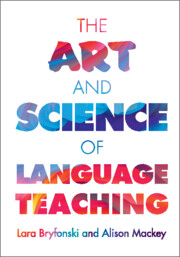88 results
L2 learning outcomes of a research-based digital app for Japanese children
-
- Journal:
- Studies in Second Language Acquisition / Volume 46 / Issue 2 / May 2024
- Published online by Cambridge University Press:
- 18 March 2024, pp. 504-534
- Print publication:
- May 2024
-
- Article
-
- You have access
- Open access
- HTML
- Export citation
Research Methods for IDs and TBLT: A Substantive and Methodological Review
-
- Journal:
- Studies in Second Language Acquisition , First View
- Published online by Cambridge University Press:
- 15 March 2024, pp. 1-27
-
- Article
-
- You have access
- Open access
- HTML
- Export citation
Glossary
-
- Book:
- The Art and Science of Language Teaching
- Published online:
- 21 December 2023
- Print publication:
- 21 December 2023, pp 331-336
-
- Chapter
- Export citation
Pre-Reading Self-Assessment
-
- Book:
- The Art and Science of Language Teaching
- Published online:
- 21 December 2023
- Print publication:
- 21 December 2023, pp xv-xxii
-
- Chapter
- Export citation
11 - How or when should I teach grammar?
- from Part III - Teaching the Skills
-
- Book:
- The Art and Science of Language Teaching
- Published online:
- 21 December 2023
- Print publication:
- 21 December 2023, pp 153-166
-
- Chapter
- Export citation
Dedication
-
- Book:
- The Art and Science of Language Teaching
- Published online:
- 21 December 2023
- Print publication:
- 21 December 2023, pp v-vi
-
- Chapter
- Export citation
Contents
-
- Book:
- The Art and Science of Language Teaching
- Published online:
- 21 December 2023
- Print publication:
- 21 December 2023, pp vii-viii
-
- Chapter
- Export citation
Part I - Teacher and Student Talk
-
- Book:
- The Art and Science of Language Teaching
- Published online:
- 21 December 2023
- Print publication:
- 21 December 2023, pp 1-74
-
- Chapter
- Export citation
4 - How do I promote peer interaction in the classroom?
- from Part I - Teacher and Student Talk
-
- Book:
- The Art and Science of Language Teaching
- Published online:
- 21 December 2023
- Print publication:
- 21 December 2023, pp 48-62
-
- Chapter
- Export citation
15 - What are some strategies for teaching learners about politeness, register, or other pragmatic skills in the second language?
- from Part III - Teaching the Skills
-
- Book:
- The Art and Science of Language Teaching
- Published online:
- 21 December 2023
- Print publication:
- 21 December 2023, pp 217-230
-
- Chapter
- Export citation

The Art and Science of Language Teaching
-
- Published online:
- 21 December 2023
- Print publication:
- 21 December 2023
-
- Textbook
- Export citation
Part II - Differentiation
-
- Book:
- The Art and Science of Language Teaching
- Published online:
- 21 December 2023
- Print publication:
- 21 December 2023, pp 75-150
-
- Chapter
- Export citation
18 - Menus and maps: How can I make my classroom more authentic in terms of materials and practices?
- from Part IV - Lesson and Unit Planning
-
- Book:
- The Art and Science of Language Teaching
- Published online:
- 21 December 2023
- Print publication:
- 21 December 2023, pp 266-282
-
- Chapter
- Export citation
1 - How do I get my learners to start and stay talking in the second language?
- from Part I - Teacher and Student Talk
-
- Book:
- The Art and Science of Language Teaching
- Published online:
- 21 December 2023
- Print publication:
- 21 December 2023, pp 3-21
-
- Chapter
- Export citation
10 - It’s much harder to learn (and teach) my language compared to other languages, and it takes much longer. How can I compensate for these difficulties with my learners?
- from Part II - Differentiation
-
- Book:
- The Art and Science of Language Teaching
- Published online:
- 21 December 2023
- Print publication:
- 21 December 2023, pp 136-150
-
- Chapter
- Export citation
19 - How could/should I best use technology in the language classroom?
- from Part IV - Lesson and Unit Planning
-
- Book:
- The Art and Science of Language Teaching
- Published online:
- 21 December 2023
- Print publication:
- 21 December 2023, pp 283-296
-
- Chapter
- Export citation
17 - Content, form, and activities: How do I select activities, tasks, and projects?
- from Part IV - Lesson and Unit Planning
-
- Book:
- The Art and Science of Language Teaching
- Published online:
- 21 December 2023
- Print publication:
- 21 December 2023, pp 249-265
-
- Chapter
- Export citation
Preface
-
- Book:
- The Art and Science of Language Teaching
- Published online:
- 21 December 2023
- Print publication:
- 21 December 2023, pp ix-x
-
- Chapter
- Export citation
9 - How can aptitude be leveraged for language learning?
- from Part II - Differentiation
-
- Book:
- The Art and Science of Language Teaching
- Published online:
- 21 December 2023
- Print publication:
- 21 December 2023, pp 123-135
-
- Chapter
- Export citation
Index
-
- Book:
- The Art and Science of Language Teaching
- Published online:
- 21 December 2023
- Print publication:
- 21 December 2023, pp 355-358
-
- Chapter
- Export citation

